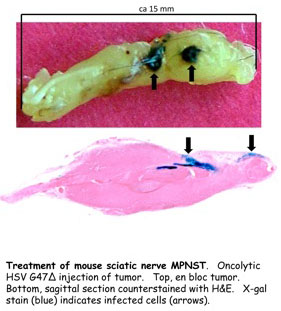


Posted August 26, 2014
Samuel Rabkin, Ph.D., Massachusetts General Hospital
 Neurofibromatosis type 1 (NF1) is the most common genetic disease causing nervous system tumors, including plexiform neurofibromas. While benign and slow growing, these tumors can be debilitating and disfiguring and can progress to malignant peripheral nerve sheath tumors (MPNSTs), highly aggressive soft-tissue sarcomas arising in peripheral nerves for which no current therapy is effective. Dr. Samuel Rabkin of Massachusetts General Hospital has developed a strategy to treat MPNSTs, injecting oncolytic herpes simplex virus (oHSV) to grow within tumor cells in order to kill them while sparing normal cells. Because MPNSTs are rare and clinical samples are difficult to obtain, development of suitable preclinical models is crucial for the advancement of new therapeutics.
Neurofibromatosis type 1 (NF1) is the most common genetic disease causing nervous system tumors, including plexiform neurofibromas. While benign and slow growing, these tumors can be debilitating and disfiguring and can progress to malignant peripheral nerve sheath tumors (MPNSTs), highly aggressive soft-tissue sarcomas arising in peripheral nerves for which no current therapy is effective. Dr. Samuel Rabkin of Massachusetts General Hospital has developed a strategy to treat MPNSTs, injecting oncolytic herpes simplex virus (oHSV) to grow within tumor cells in order to kill them while sparing normal cells. Because MPNSTs are rare and clinical samples are difficult to obtain, development of suitable preclinical models is crucial for the advancement of new therapeutics.
With support from an FY06 NFRP Therapeutic Development Award, Dr. Rabkin developed two orthotopic sciatic nerve MPNST models: one utilizing mouse MPNST cell lines derived from spontaneously arising tumors implanted into immunocompetent mice and the second with human MPNST cancer stem-like cells (MSLC) implanted into immunodeficient mice. These mice were assigned neurologic scores based on their hind-limb function before and after implantation with a baseline score of 10 points for normal hind-limb function. Once the neurologic score decreased to 8 or 9 points, G47Δ, a third-generation oHSV, was injected. Dr. Rabkin continued to score the mice based on neurologic function and, in both orthotopic mouse models, G47Δ injection resulted in a smaller decrease in neurologic score over time compared with the control mice. Furthermore, G47Δ treatment led to decreased tumor size and increased overall survival in these mice.
Dr. Rabkin next expressed various therapeutic transgenes, such as platelet factor 4 (PF4) and interleukin 12 (IL-12), in the G47Δ oHSV system in order to increase its cytotoxic, antitumor effects. G47Δ-PF4 did significantly extend survival in the mouse models compared to G47Δ alone. Additionally, G47Δ-IL-12 injections resulted in a significant delay of tumor growth with no measurable tumors present until day 17, compared with day 10 for the control and G47Δ-only injections. G47Δ-IL-12 also fared better on all outcome measures, including neurologic score, tumor size, and overall survival. Taken together, these results provide an exciting avenue for new therapeutics to treat MPNST tumors. Dr. Rabkin has received additional funding from an FY10 NFRP Exploration - Hypothesis Development Award to continue his development of novel therapeutics for individuals with NF1. In addition, Dr. Slawomir Antoszczyk, a collaborator in Dr. Rabkin's lab, has received an FY09 Postdoctoral Traineeship Award to further augment these efforts. Dr. Rabkin and his team are committed to continuing research in NF1 and to finding therapies that will help those affected by it.

Publication:
Antoszczyk S, Spyra M, Mautner VF, et al. 2014. Treatment of orthotopic malignant peripheral nerve sheath tumors with oncolytic herpes simplex virus. Neuro-Oncology 16(8)1057-1066.
Links:














